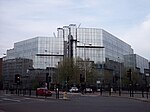The Bartlett
The Bartlett Faculty of the Built Environment (or The Bartlett) is the academic centre for the study of the built environment at University College London (UCL), part of the University of London in London, United Kingdom. It is home to twelve departments that have expertise in individual fields of the built-environment, including the Bartlett School of Architecture, Bartlett School of Planning, Bartlett Development Planning Unit, and Centre for Advanced Spatial Analysis. The Bartlett is consistently ranked the highest in Europe and the UK and among the highest in the world for the "Architecture and the Built-Environment" category in all major rankings. In the 2019 QS World University Rankings, it was ranked first in the world, and is currently ranked 2nd in the 2021 Rankings.
Excerpt from the Wikipedia article The Bartlett (License: CC BY-SA 3.0, Authors).The Bartlett
Harrington Street, London Fitzrovia (London Borough of Camden)
Geographical coordinates (GPS) Address Nearby Places Show on map
Geographical coordinates (GPS)
| Latitude | Longitude |
|---|---|
| N 51.53 ° | E -0.14 ° |
Address
Harrington Street
NW1 3SL London, Fitzrovia (London Borough of Camden)
England, United Kingdom
Open on Google Maps









